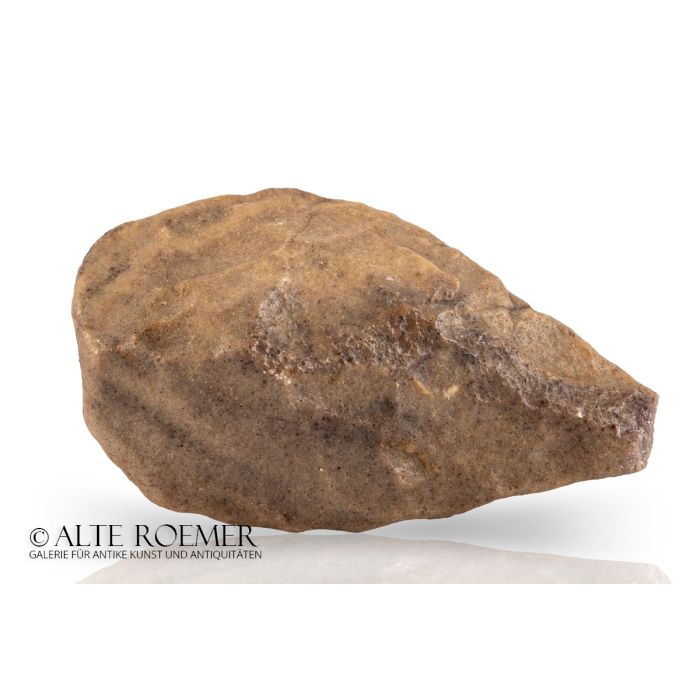Paleolithic hand axe
Price: on request
Sold
Object number
AR3355-13
| Object: |
Paleolithic hand axe
|
| Material: |
Stone.
|
| Period: |
About 500,000 BC to 200,000 BC, Paleolithic, Difficult to date, as the shape has hardly changed over thousands of years. |
| Description: |
Hand axe from the Palaeolithic. Clear traces of working. Heavy object, tapering to the front, easy to grip at the back.
|
| Background: |
The hand axe was the universal tool of the Paleolithic. With its sharp edges one could, for example, cut plants or cut up meat. The pointed end could be used as a drill. The tool looks simple at first glance, but different working techniques had to be combined for its manufacture. The Stone Age craftsman had to have some experience and plan the processing steps carefully. The hand axe can therefore be regarded as the first high-tech product in human history and remained state of the art for around a million years. |
| Dimensions: |
13.6cm long.
|
| Condition: |
Tip broken off and missing. Otherwise very good condition. Sticker from a previous owner inscribed "Mehedjibat 82".
|
| Provenance: |
Acquired by us on the Swiss art market in 2022. Previously in the Swiss collection of Alfred Huber, acquired in 1998 when Mr. Huber was director of the Burghalde Museum in Lenzburg, Switzerland. The acquisition was made from the collection of the Bally-Prior Museum in Schönenwerd, Switzerland. Added to the museum collection between 1860 and 1989. Erg Mehedjibat has been passed down as the find spot. It is a place in the Sahara desert, located near the oasis town of In Salah in Algeria, North Africa. An invitation and encouragement to devote oneself to the study of art and nature and to love the subject. This is what the Bally-Prior Museum should be for the youth. And this is why the founder of the museum granted free admission to young visitors. He himself, Peter Eduard Bally-Prior (1847-1926), began collecting early in his life. He passionately devoted himself to minerals, fossils, as well as archaeological and ethnological rarities. His successful career as an industrialist and Swiss National Council gave him ample funds for his passion. He financed six large archaeological excavations in Switzerland and took the time to write accademic publications on history. The Bally-Prior Museum in Schönenwerd Switzerland opened in 1910 to make the already huge collection accessible to the public. Shortly before the death of the founder in 1926, the museum opened a new wing to accommodate new additions to the collection. After almost a century, in 1998, the museum foundation decided to close down and sell the exhibits. Museums, universities and private individuals rushed to acquire a part. It was people who had love for the subject. Exactly the passion Eduard Bally-Prior wanted to awaken with his museum. |
| References: |
Cf. C. E. Klenkler, Sahara - Objects Prehistoriques / Prähistorische Artefakte, 55 to 57.
|
| Authenticity: |
We unconditionally guarantee the authenticity of every artefact, all items are subject to our lifetime return policy on authenticity.
|


